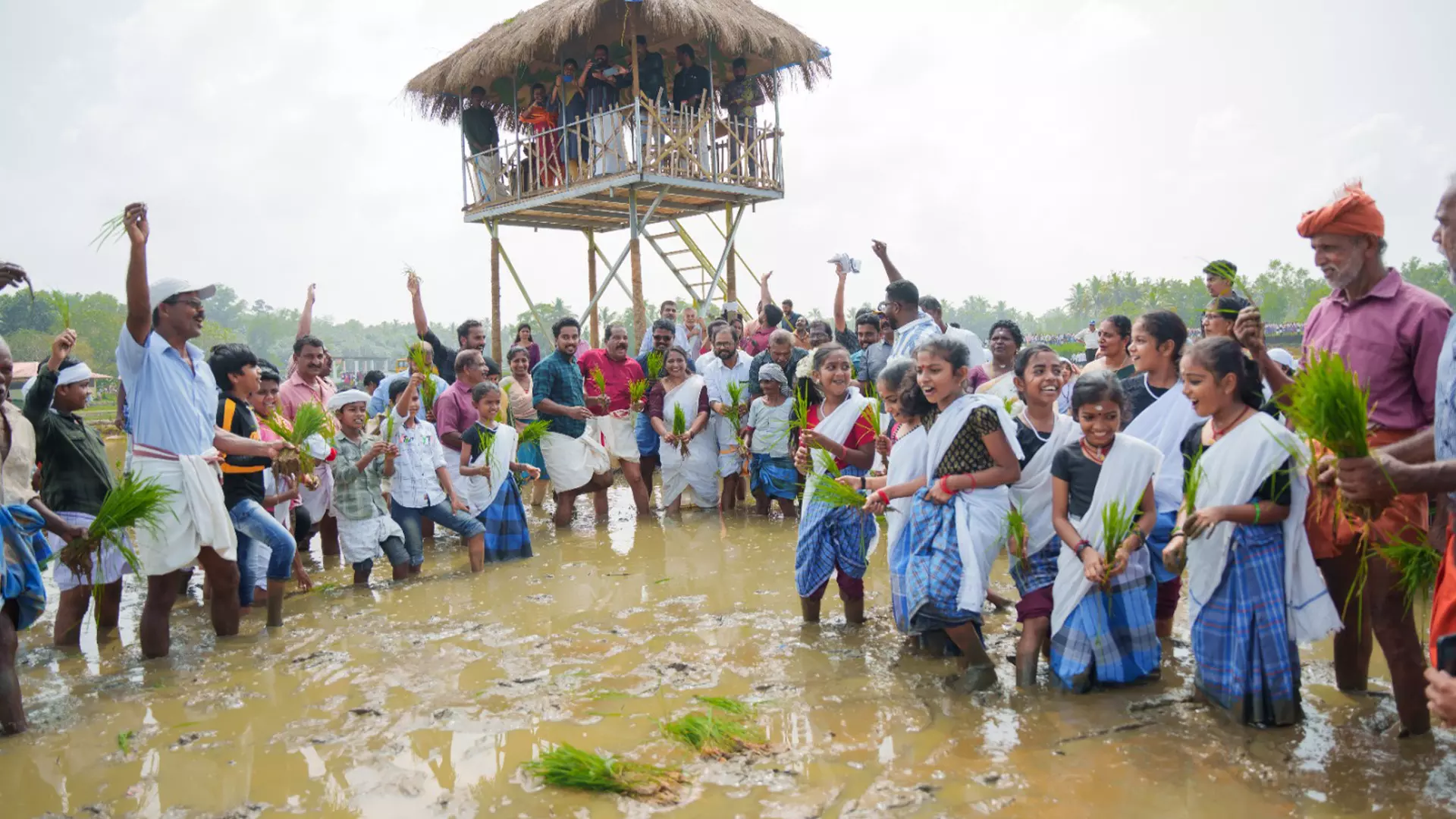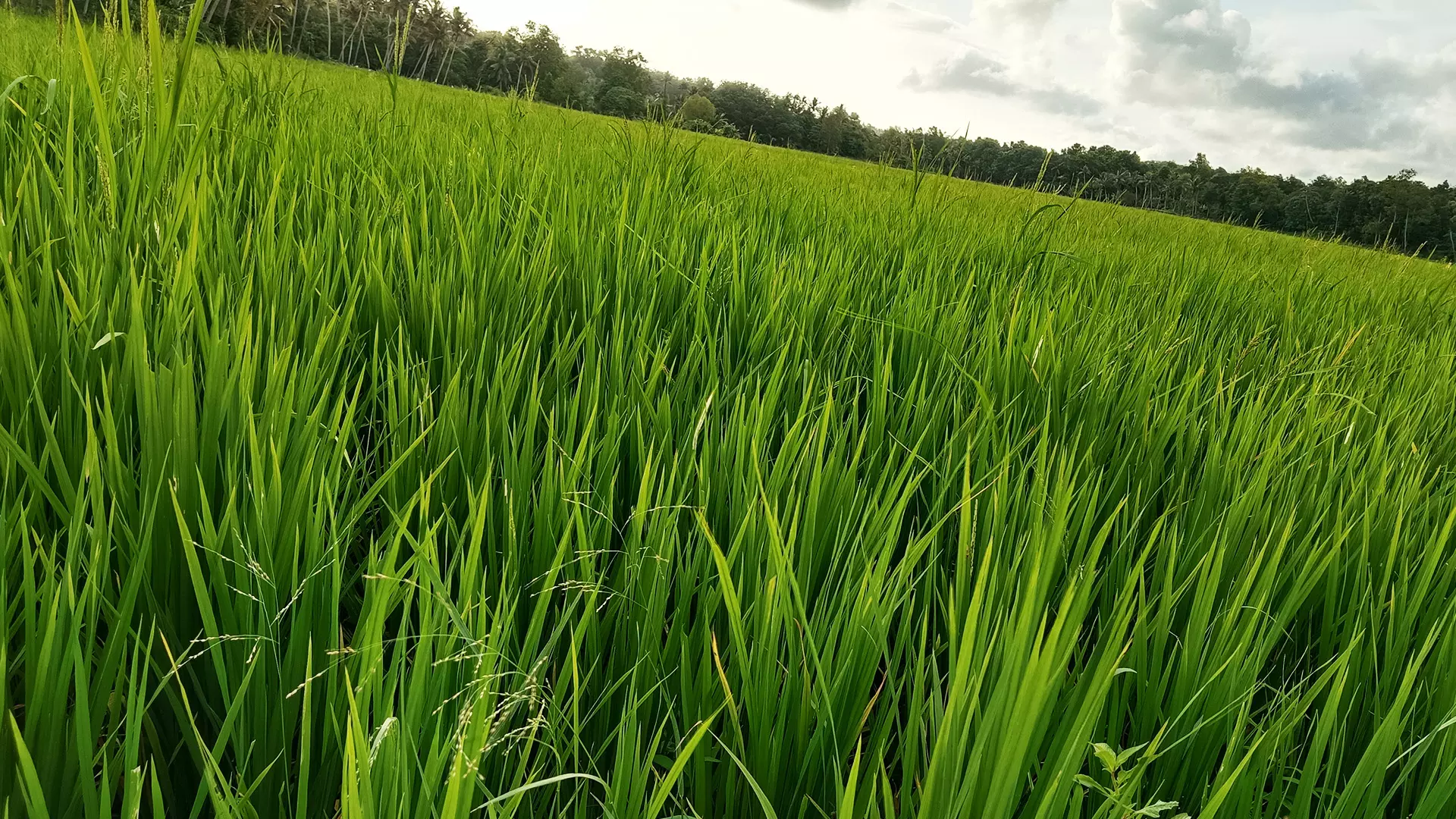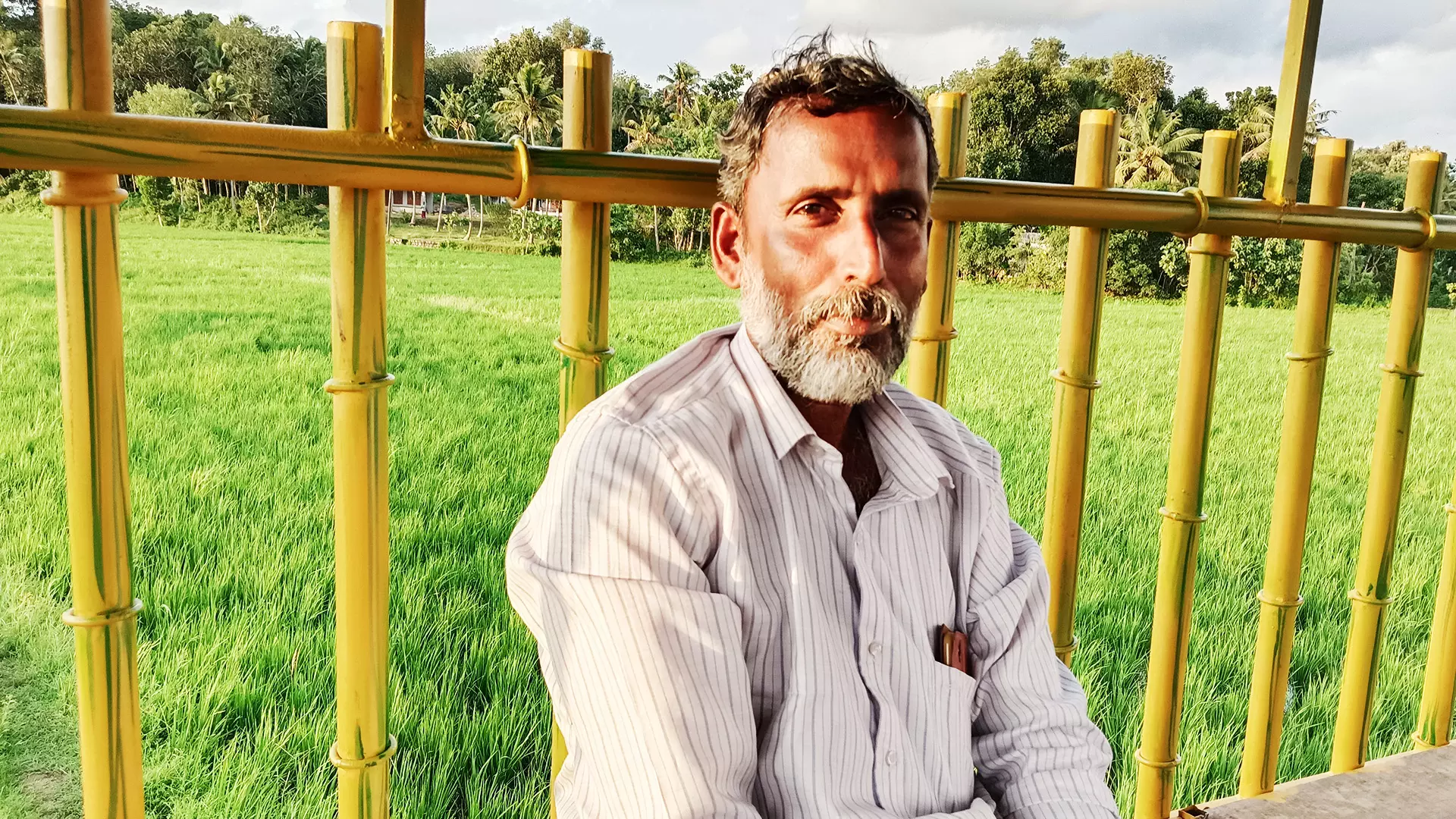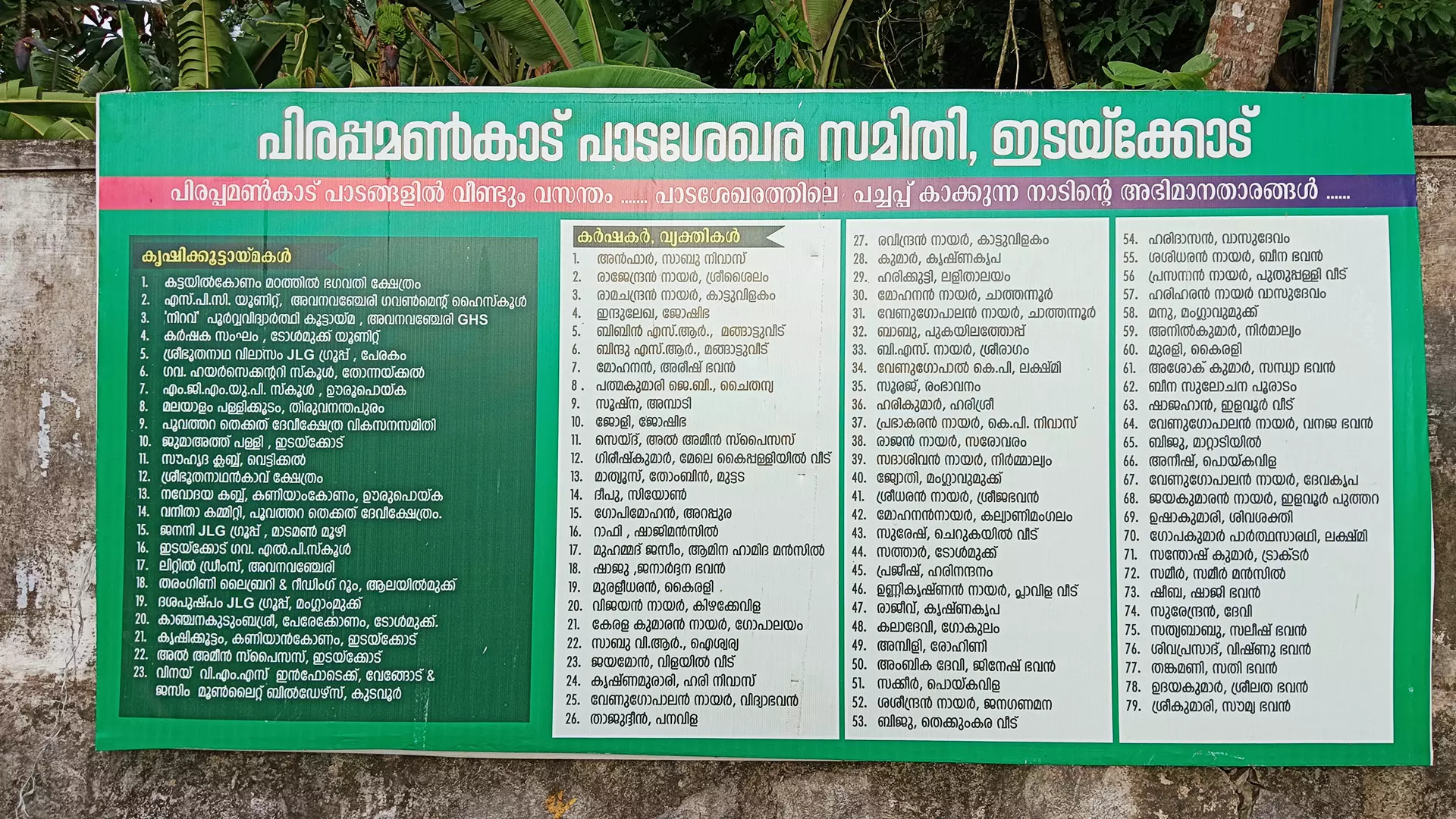
- Home
- India
- World
- Premium
- THE FEDERAL SPECIAL
- Analysis
- States
- Perspective
- Videos
- Sports
- Education
- Entertainment
- Elections
- Features
- Health
- Business
- Series
- In memoriam: Sheikh Mujibur Rahman
- Bishnoi's Men
- NEET TANGLE
- Economy Series
- Earth Day
- Kashmir’s Frozen Turbulence
- India@75
- The legend of Ramjanmabhoomi
- Liberalisation@30
- How to tame a dragon
- Celebrating biodiversity
- Farm Matters
- 50 days of solitude
- Bringing Migrants Home
- Budget 2020
- Jharkhand Votes
- The Federal Investigates
- The Federal Impact
- Vanishing Sand
- Gandhi @ 150
- Andhra Today
- Field report
- Operation Gulmarg
- Pandemic @1 Mn in India
- The Federal Year-End
- The Zero Year
- Science
- Brand studio
- Newsletter
- Elections 2024
- Events
How a group of farmers in a Kerala village brought paddy back to unused fields

A group of children following a slow-moving crab on the tiny mud bund of the vast and green paddy fields was a common scene in Kerala three decades ago. The crab would rush towards its burrow on the side of the bund to save itself. Once inside, it would not dare to come out. The children would wait until they got another one to chase. You may not see such encounters taking place in the...
A group of children following a slow-moving crab on the tiny mud bund of the vast and green paddy fields was a common scene in Kerala three decades ago. The crab would rush towards its burrow on the side of the bund to save itself. Once inside, it would not dare to come out. The children would wait until they got another one to chase. You may not see such encounters taking place in the paddy fields of Kerala today, as cultivation of paddy has come down drastically in the state since 2000 due to high labour cost, urbanisation and climate change.
If you look at the history of paddy cultivation, you will know how it was closely linked to the social and cultural life of the people. The once vibrant paddy fields of Kerala are no more today. Although the state government brought in the Kerala Conservation of Paddy Land and Wetland Act in 2008 to curb the conversion of paddy land, it was too late. Acres of paddy fields had been converted to lands by then. Those who couldn’t convert their paddy fields to residential lands left farming and as a result many paddy fields have been lying unused in the state.

Farmers and their families enjoying with their harvest in Pirappamankadu.
A couple of years ago, a group of people of Pirappamankadu in Edakkodu, a village 10 km from Attingal in Thiruvananthapuram district, decided to find a solution to it. More than 100 acres of paddy fields had been lying unused in the village which once produced tens of thousands kilograms of rice during the harvest. Even though some traditional farmers continued cultivation of paddy, 90 per cent of the paddy lands in Pirappamankadu remained unused. Covered with thick shrubs and trees, the once vibrant paddy fields became a hideout for anti-social elements. What the villagers first did was rejuvenate the activities of the Pirappamankadu Paadasekhara Samithi (PPS), an organisation of farmers of the locality with the objective of promoting cultivation of paddy and allied crops. A committee comprising 11 members was formed, and the team started visiting the houses of the owners of the paddy fields in Pirappamankadu which were lying unused for the last two decades.
The members walked into the houses of owners of the paddy land with two options. They could either cultivate paddy on their own or lease it out to PPS. The only condition that the team put forward was that the process related to the cultivation should start at the same time. While some agreed to the idea, a few said, “they didn't want to do anything”. Repeated appeal to the owners, however, helped.
In 2023, the PPS first launched paddy cultivation in 47 acres. Harvest in the first phase yielded 56,000 kg of paddy and the second phase, 81,000 kg. The third phase (in 76 acres) harvest will take place by September-end. Even though the villagers worked hard to resume cultivation of paddy in Pirappamankadu, there were challenges in the beginning. Lack of water was the biggest issue, as the nearby pump house which once supplied water to the paddy fields stopped functioning. Shortage of water in the nearby Mamam River added to the woes.

In 2023, PPS first launched paddy cultivation in 47 acres. Harvest in the first phase yielded 56,000 kg of paddy and the second phase, 81,000 kg.
With the help of the Krishi Bhavan, the issue was solved. The pump house was restored and water started pouring to the paddy fields. The clearing of shrubs and weeds from the field was another task. The members of the PPS organised a number of cultural activities such as paddy field walks, get-togethers and knowledge-sharing workshops to attract more people to the initiative. “In 2023, when we were nearing the harvest, the entire field was flooded due to heavy rain. Our tractor was damaged in the flood. We felt sad. The water, however, receded fast. But then there was a deadly attack of weevils. We put up flambeaux around the paddy fields to solve it. Shortage of water, flood, weevils and a flooded tractor. There were hurdles one after the other. But we could overcome it all with a great sense of devotion,” said Sabu VR, a retired headmaster and president of the PPS.
The more the villagers faced struggles the more they became active. People from outside the village started joining the initiative. A watch tower was built with the support of the villagers in the middle of the paddy fields. Girish Kumar, who won the best farmer award in the Mudakkal panchayat, said, “Even though many people left their paddy fields, I continued my agricultural activities as that is the only job I am trained in. Cultivation of paddy gives great hope and I am happy now that more people are returning to farming,” he said. Girish said he could earn a fairly good profit by selling rice to the wholesale market. The PPS invited schools and other organisations in the region to participate in the initiative. The result was positive.

Girish Kumar won the best farmer award for paddy cultivation.
Once the first harvest was over, the PPS placed a hoarding near the Shree Bhoothanatha temple with the names of all the 79 farmers who participated in the initiative. For Ramadevi Amma it is an unending process. A trained paddy farmer, she knows how to plant the seedlings without any error. “As a child, I was part of the cultivation of paddy. We were given paddy as remuneration for the day’s work. It was a great feeling. I am happy that we could bring paddy back to the fields. It is a great feeling,” said the 68-year-old. Ramadevi said age is just a number and she will double her paddy cultivation in the forthcoming season. “I am thrilled, and I want to do more. If we do paddy cultivation properly, in a systematic order, we can definitely make good profit. And that's what we are doing here now,” she added.
Paddy is cultivated in the districts having a unique three season pattern – Kharif (July-October), Rabi (November-February) and Summer (March-June). Water is an essential input for the growth of paddy which perhaps consumes the largest quantity of water when compared to other wet crops. Even though the paddy fields belong to various people, the role of PPS is big. “We sowed the paddy seeds in a nearby field. We used Uma, a popular paddy seed known for its high yield. We supplied paddy seedlings to the farmers and it encouraged many to come forward and resume paddy cultivation,” said Sabu.

Lily Kumari, a farmer, said it was a dream-come-true moment for her when she and her friends first experienced the harvest in Pirappamankadu after more than two decades. “When we do good things, people come and support us. Many parents come with their children to see the vast paddy fields of Pirappamankadu. We are proud of our paddy fields now,” she said. For Venugopalan Nair, it is a remarkable resurgence. “The Pirappamankadu paddy fields near the Shree Bhoothanatha temple have reclaimed their glory after two decades. Despite the vagaries of weather, the lush green landscape has emerged, symbolising a newfound hope for this village. This triumphant return to the land is a great reminder of the agricultural splendour that was feared lost, yet remains an indelible part of the collective identity of the village. It is a moment of celebration for us,” said Venugopalan Nair, a native of the village, who works as legal advisor to a leading finance company based in Chennai.
As the villagers get ready for the third season of harvest, Sabu said the PPS has just started selling the Pirappamankadu Brand Rice (kuthari) in five kilograme packets through various stalls and shops. A sample pack of it was launched by G R Anil, minister for food and civil supplies, a couple of weeks ago. The minister also opened a mill in Edakkodu for the production of the brand. The initiative gives hope to many farmers who left the paddy cultivation long ago. “We are a team of people from various walks of life. There are youngsters and elders, women and children. Cultivation of paddy is associated with our social and cultural life. We are getting huge demands from various sectors for the rice. Our farmers are happy and they got a good yield last time. We hope it will continue,” said Sabu.
The renewed cluster of paddy fields of Pirappamankadu is one of the biggest of its kind in Thiruvananthapuram today.
